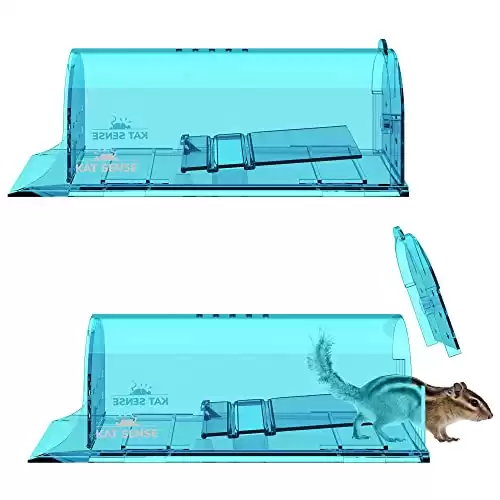| Best for | Product |
|---|---|
| Best for Allergies | Hoover Power Drive Bagless Upright Vacuum Cleaner |
| Best for Bulk Food Storage | Gamma2 Vittles Vault Stackable Airtight Pet Food Storage Container |
| Best Live Traps | Large Humane Rat Traps, Set of 2 |
| Best Electronic Trap | TRJETIFE Electric Rat Trap |
| Best Bait Box | Outpost Rat Bait Station |
No one likes to think about rats living inside their home. Many people are afraid of them, while most are just disgusted. Researching rat infestations is an excellent step in the right direction. Especially if you have a hunch these critters are in your house.
The sooner you can verify the problem, the sooner you can implement a solution. You don’t want to wait until you find the rats have eaten through one of your family albums or your last candy bar. This post will make you feel like an expert and ready to check your house. With these pro tips, you’ll be able to tell what is going down in your home, so keep reading!
1. Rat Droppings
Rat droppings are small, dark pellets that are usually found in clusters. If you find them around your home, it’s a good indication that rats are present. This is because rats will often leave droppings wherever they travel. You’re most likely to find rat droppings in kitchens and pantries and storage areas such as attics and basements.
However, rat droppings can also be found in other home areas, such as garages and sheds. The droppings can also spread disease, so cleaning them up as soon as possible is essential. You can do this by vacuuming the droppings and then wiping the area with a soapy washcloth. You should use gloves before starting and wash your hands imminently after. Once it’s dried, disinfect the area with bleach or any disinfectant spray or wipes you have available. You may also want to disinfect the hose opening of your vacuum hose.
- Swivel steering makes it easy to navigate hard-to-reach areas
- Features advanced action brush roll to make vacuuming effortless
- Works on carpet and hard surfaces
- Extra-large dirt cup means fewer trips to the garbage can
- Quick-release cleaning wand makes for easy cleaning transition
2. Look for What Rats Chew On
Rats are often considered to be pests and for a good reason. Not only do they carry diseases, but they will also gnaw on just about anything. This includes papers, insulation, and even wires and pipes. Rats are known to gnaw on several things such as papers, wires, and even trash. This is because rats constantly urge to chew, and their teeth never stop growing.
While rat gnawing may not seem like a big deal, it can cause significant damage to your property. Rats chewing on wires may even lead to a fire. Electrically fires are dangerous and are difficult to put out. Preventing this can be done by making sure you don’t have rats in the first place. The best places to check for where a rat chewed are places with items they like to nibble at, like a junk drawer with mail inside.
3. Check Your Food Packages
You can blame rats if you’ve ever found your cereal box with holes chewed in it. They are attracted to the smell of Cheerios and other packaged foods. Rats often gnaw on containers in search of a meal. While this may seem insignificant, it can pose a severe health risk.
Since rats carry diseases that can be transmitted to humans through contaminated food, it’s important to inspect any food items that are left out where a rat can get them. Rats are drawn to food like most animals and don’t see the harm in having some of yours. You can identify nibble marks often on the corners of food boxes, or droppings may be near or stuck to the item.
- Airtight container
- Holds up to 40 pounds of food
- Heavy Duty BPA-Free HDPE Plastic
- Perfect for storing pet food and even bulk human food such as cereals
- Keeps food fresh and free from unwanted moisture
4. Find Rat Burrows
Rat burrows are small tunnels that rats use to travel and nest. They are typically found in areas with a lot of vegetation, such as near bushes or trees. If you see any suspicious burrows around your property, it’s a good indicator that rats are present. Rat burrows can pose a severe threat to your home, allowing rats to enter your house.
If you suspect that rat burrows are present on your property, you can do a few things to confirm your suspicions. First, look for rat droppings near the burrow entrance. Second, try to block off the rat burrow entrance with a piece of cloth or paper. If the rat burrows are active, the fabric or paper will be pushed out from the inside.
- Cruelty-free
- Captures rats without killing them so you can release them away from your home
- Child and pet friendly, with no bait blocks or snaps to damage fingers, paws, or noses
- Recommended by animal rights organizations such as PETA
- Available in sizes for rats and for mice
5. Listen for Late Night Noises
If you find yourself spooked at midnight by mysterious noises, your first thought is probably to call Ghostbusters or Ghost Facers, depending on what Netflix series you binge on in your free time. Since rats are often active at night, you are more likely to have a rat infestation if you hear strange noises from your walls or ceilings.
Rats are nocturnal animals and are most active after the sun goes down. They are often drawn to homes in search of food or shelter. You may also hear rats scratching or scurrying in your walls or ceilings. You may wake up from the sounds if you are a light sleeper. However, heavy sleepers could try to stay up later to see if they hear anything at night in their walls.
- Releases 6,000 - 9,000 volts of electricity for up to 4 minutes to kill rats instantly without pain
- Features an anti-escape door
- Also allows users to capture rodents unharmed for release
- A safety switch prevents pets from being electrocuted
- Designed so you can dispose of rodents without seeing or touching them
What Other Signs May Indicate a Rat Infestation?
A house that has a rat infestation often has a distinct smell. The smell is caused by the rats’ urine, which is full of ammonia. Ammonia is a strong-smelling gas that can harm humans if inhaled in high concentrations. In addition to the ammonia smell, a house with a rat infestation may also have a musty or moldy smell.
This is because rats are often attracted to damp areas, and their presence can exacerbate the problem of mold growth. Another reason for this smell is their droppings. If they are near your vents, this smell can be very potent. It can be challenging to tell if you’re in your house a lot, so after stepping out for fresh air, watch for any odors you may find entering your home.
What to Do if You Think You Have a Rat Infestation
If you suspect a rat problem, you must take action immediately. You can contact a pest control company to get rid of the rats. You can also try to get rid of them, but this can be difficult, and it’s crucial to ensure that you do it safely. The first step is to determine how the rats get into your home.
Once you’ve found the entry point, you can seal it with steel wool or caulk. It would be best if you researched what trap and poison options are recommended for your situation. If you’re uncomfortable handling this situation, you can always contact a professional to do it for you. Either way, taking care of a rat infestation is vital to keeping your home safe and clean.
- Secure, compact, high-quality, lockable, and tamper-resistant
- Can be installed vertically or horizontally
- Eliminates mice and rats
- Place along walls and other rodent pathways
- Made in the U.S.A.
Conclusion
Make sure to check for droppings in your cupboards or on your countertops. If you see any of these, it’s a good indication that you have a problem. You can also try setting up a rat trap. Baited with cheese or peanut butter, these can be effective in catching rats. If you catch one, that’s a clear sign that you have an infestation. Rats like to gnaw on things, and they can quickly destroy wiring, insulation, and wood.
Rats are pests that no one wants in their home, so taking action as soon as possible is essential. With all the steps listed above, you should be able to find out if you have a rat infestation or not. Hopefully, you don’t have one, but it never hurts to know what to do just in case.
It’s never fun if you’re dealing with a rat problem. Rats can cause severe damage to your house and belongings, so taking care of the infestation as quickly as possible is crucial. If you see any signs of chewing or gnawing, it’s a good idea to call an exterminator or start handling the problem yourself.
Up Next…
Rats in an Old House: 5 Steps to Getting Rid of Them
| Best for | Product |
|---|---|
| Best for Allergies | Hoover Power Drive Bagless Upright Vacuum Cleaner |
| Best for Bulk Food Storage | Gamma2 Vittles Vault Stackable Airtight Pet Food Storage Container |
| Best Live Traps | Large Humane Rat Traps, Set of 2 |
| Best Electronic Trap | TRJETIFE Electric Rat Trap |
| Best Bait Box | Outpost Rat Bait Station |
Thank you for reading! Have some feedback for us? Contact the AZ Animals editorial team.









